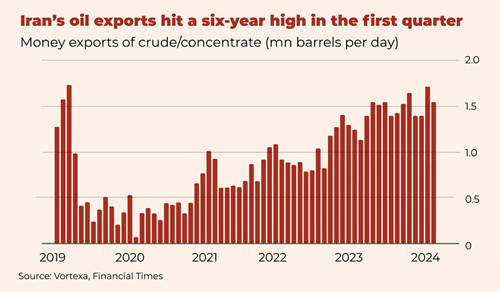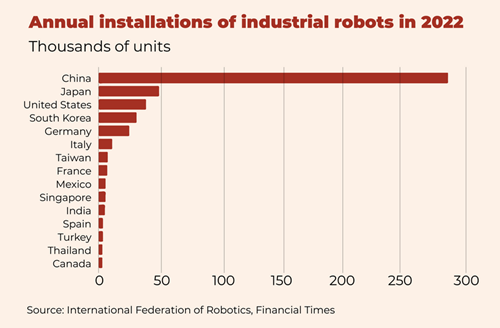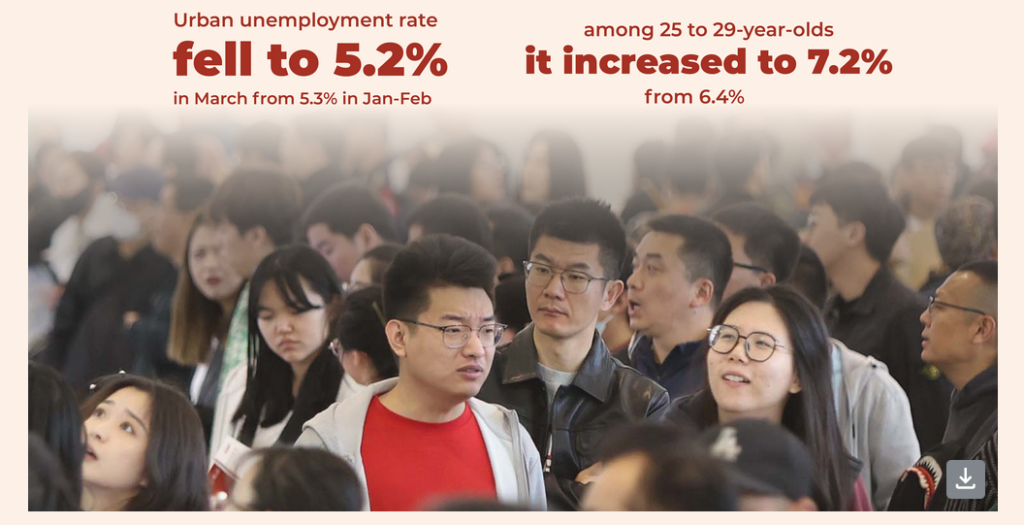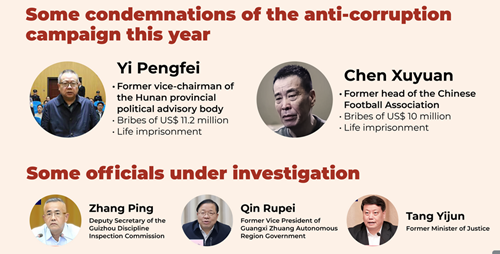Overcapacity: The West’s New Narrative against China
This week we would like to recommend to you a Chinese song from 1967 called Bravely March On, Arab People! (奋勇前进,阿拉伯人民) in support of the pan-Arab movement.
If you don’t have a lot of time, this is what you should know:
- For China, Iran’s attack on Israel was “an act of self-defense”
- The West’s new narrative against China: overcapacity
- China exceeds its 5% GDP growth target in first quarter
- Historic “peace trip” by former Taiwanese leader Ma Ying-jeou
For China, Iran’s attack was “an act of self-defense”
In the context of the genocide that Israel is perpetrating on the Palestinian population, and in retaliation of Israel’s attack on its embassy compound in Damascus (Syria), Iran carried out a missile and drone attack on Israeli territory for the first time in history, repeatedly puncturing the famous “iron dome”.
After the military response, Wang Yi, China’s foreign minister, called his Iranian counterpart Hossein Amir-Abdollahian. During their discussion, Wang Yi again condemned Israel’s “unacceptable” attack on the Iranian embassy in Syria, saying it was a serious violation of international law. He also stated that “Iran can handle the situation well and prevent the region from further turmoil while safeguarding its sovereignty and dignity.” The Iranian foreign minister assured Foreign Minister Wang that his country was willing to be moderate and had no intention of escalating the situation further. He further stressed that “the Islamic Republic of Iran advocates an immediate ceasefire in Gaza and supports China’s positive efforts to promote a ceasefire.”
In contrast, Yuval Waks, deputy head of the Israeli mission to China, said Israel was not satisfied with China’s current response to Iran’s attack as, in his words, they had expected “a stronger condemnation and a clear recognition of Israel’s right to defend itself.”
A few days later, the US House Speaker labeled Iran, China, and Russia the new “axis of evil” while supporting the latest bill to send $60 billion to Ukraine.
For years, China has advocated a two-state solution, the creation of an independent Palestinian state, and full Palestinian membership in the UN. In fact, last week, it again supported a UN Security Council motion to that effect, but it was vetoed, once again, by the United States.While everyone is talking about Iran’s actions in recent weeks, a major shift in Iran’s energy trade has been taking place in recent years. Despite Western sanctions, Iran’s oil exports reached a 6-year high, boosting its economy by $35 billion per year.
Iran sold an average of 1.56 million barrels per day, of which the vast majority were sold to China. Approximately one-tenth of China’s oil imports come from Iran.
This makes it more difficult for the new sanctions that the United States and Europe may impose because of the conflict with Israel to really affect the Iranian economy. We could be witnessing a phenomenon similar to that of the Western sanctions against Russia since February 2022: by increasing trade with the economies of the Global South, driven by China, which does not engage with Western sanctions, the economy, which in theory should suffer, ends up strengthening and reducing its dependence on the West. It is too early to say but the indications provided by Iranian oil exports seem to point to this.
The West’s new narrative against China: overcapacity
During her visit to China at the beginning of April, US Treasury Secretary Janet Yellen expressed her concern about an alleged overcapacity in the Asian giant’s new energy sector. In the last few weeks, this idea has been circulating in the Western media, accusing the Chinese government’s subsidies to energy sector companies as “unfair”. However, the decision to subsidize or not an industrial sector is a national sovereignty decision of the country and a common practice in international trade. The fact is that Europe heavily subsidizes its agricultural sector (and has even been accused of dumping practices) and, historically, the United States has had a protectionist policy to boost its domestic industry. The bottom line is that both the US and Europe are concerned about China’s sweeping advance in the production of electric cars, solar panels, technology, and robotics, products at the core of China’s current industrial development.
A good example is China’s largest automation company Innovance, which has a market capitalization of US$ 25 billion. Known as “little Huawei”, it was founded by former Huawei engineers and today is the main supplier of AC servo systems parts (those that produce motion in industrial machines) and the second largest national producer of industrial robots. Its 2023, revenues increased by 30% to US$ 4 billion; its R&D investment is significant, and it has two factories in Hungary and one in India.
According to figures from the International Federation of Robotics, in 2022 more than half of all industrial robot installations in the world were in China.
This boost in China’s new energy industries is an opportunity for countries in the Global South, Dongsheng member Marco Fernandes told CGTN in an interview. He emphasized that “…it is the first time that we have a major economy, such a strong economy in the Global South, so it is absolutely strategic” and that for developing countries it is “…a matter of trying to have balanced partnerships”.
In this way, China’s alleged overcapacity seems more of a threat to the traditional powers than to the world’s developing countries. Both Europe and the United States insist on decoupling or “de-risking” from China, but the data show that such a thing is far from being achieved. According to a Brookings paper last year, US manufacturers are far more dependent on China than standard calculations that examine the origin of intermediate goods, i.e., imports used to make US products, suggest.
The paper reveals that, in 2018, China was the supplier for more than 90% of US manufacturing sectors, particularly apparel, motor vehicles, and electrical equipment. In 1995, Japan was the main foreign source for about 40% of US manufacturing sectors, followed by Canada with about 30%. This high dependence on Chinese intermediate goods implies, for the authors, that “decoupling from China will be much, much more difficult and much slower than many people think, and may be impossible.”
In the same vein, it was Siemens CFO Ralf Thomas who said a few days ago that it will take “decades” for German manufacturers to reduce their dependence on China. “Global value chains have been built up over the last 50 years – how naive do you have to be to believe that this can change in six or 12 months?” he remarked. This is a small sample of the dependence that European countries also have in their trade with China. Following Chancellor Olaf Scholz’s visit, China announced that it will reduce controls on German agricultural products, including pork, apples, and some beef products. Similar measures were taken earlier this year on products from Spain, Belgium, and Austria, in a clear sign of Beijing’s intentions to improve its ties with Europe.
First quarter economy: China exceeds its 5% GDP growth target
China’s economy exceeded expectations and grew by 5.3% year-on-year in the first quarter, consistent with the annual growth target of “around 5%” set at the Two Sessions earlier this year.
Amid China’s productive reorganization, based on manufacturing, not real estate, as the cornerstone of growth, the investment in fixed assets reached 10 trillion yuan (1.4 trillion USD), up by 4.5%. Amid the restructuring of industry, investment in real estate continues to fall (-9.5%), while manufacturing and infrastructure made up the overall growth in investment, increasing by 9.9 and 6.5%, respectively.
China’s industrial value-added grew 6% in the first quarter, especially in the high-tech sector whose manufacturing growth accelerated. China’s central bank will set up a 500 billion yuan ($70 billion) re-lending program to support the country’s science and technology sectors for small and midsize companies.
On the international front, the use of the RMB in international transactions continued to grow. According to SWIFT, the share of the yuan in global payments rose to a record high in March (4.69%), remaining the world’s fourth most active currency. The US dollar continued to have the largest share in global payments, at around 47% and the euro fell below 22%.
When SWIFT began tracking the use of the yuan in 2010, the currency accounted for less than 0.1 percent of global settlements.
Moreover, the use of the yuan in China’s cross-border transactions for trade in goods was nearly 30% in the first quarter, up from 25% in 2023 and 18% in 2022.
Historic “peace trip” by former Taiwanese leader Ma Ying-jeou
Ma Ying-jeou, the former leader of the island of Taiwan from 2008 to 2016, made a peace trip to mainland China where he met with Xi Jinping. At the meeting, Xi affirmed that “there are no problems that cannot be discussed and no forces that can separate us” and that “external interference cannot contain the historical trend of national reunification”. For his part, Ma said that upholding the 1992 Consensus and opposing “Taiwan independence” are the common political basis for the peaceful development of cross-Strait relations.
Ma belongs to Taiwan’s main opposition Kuomintang party, which is more inclined to maintain a friendly relationship with the mainland. The Democratic Progressive Party, which has ruled since 2016, won the last regional elections. In a few days, the new leader William Lai Ching-te, who will succeed Tsai Ing-wen, will take office. Since Tsai came to power in 2016, talks with the central government have been frozen since the Taiwanese government stopped recognizing the 1992 Consensus that respects the One China principle.
It remains to be seen how these relations will develop with the new government. Ma, after his visit to the mainland, urged the elected leader to respond “pragmatically” to Xi Jinping’s call for peace, and to respect the One China principle.
China launches third round of anti-corruption inspections of the financial sector
China launched another series of disciplinary inspections of key government departments and state-owned financial institutions.
The third round of routine inspections, following the last one in 2021, will target 34 agencies, including central government ministries, the central bank, the Shanghai and Shenzhen stock exchanges, the largest state-owned banks and insurers, as well as policy lenders.
The anti-corruption campaign launched by Xi Jinping in 2013 has covered all sectors of governance. From ministries, finance, and state-owned enterprises, to health and sports. More than four million CPC regional cadres and 533 at the vice-ministerial level and above have been investigated since the start of the anti-corruption campaign.
Pork prices plummet in China
Chinese pork prices are in a prolonged slump due to oversupply. After peaking at 26 yuan (US$ 3.6) in October 2022, they have now hit a low of 14 yuan (US$ 1.93). This product accounts for 60% of the country’s meat consumption, so fluctuations in its prices have multiple implications.
- For a start, it puts deflationary pressure on the Consumer Price Index, which in March rose by 0.1% year-on-year, below the government’s 3% target.
- If China decides to reduce the number of pigs raised, it will most likely have an impact on the global grain market, as a decrease in feed demand will put downward pressure on international prices.
- In addition, the downward price trend puts producers at risk of bankruptcy and may put many small producers out of production, as has happened on other similar occasions.
That is why the Chinese government started to take action, announcing plans to reduce its target number of breeding sows by about 5% starting in March, from 41 million to 39 million. In addition, it will consider 92% of that target (about 35.9 million sows) as an acceptable level.
China’s coastal cities will be below sea level within a century
A quarter of China’s coastal land will sink below sea level within a century, according to a new study by Chinese and US researchers published in the journal Science. They found that about one-third of the population of the 82 cities analyzed live in regions that drop more than 3 mm per year, while 7% live in areas that drop more than 10 mm per year. The paper also found that 270 million Chinese currently live on subsiding land.
Changes in groundwater and the weight of construction would be among the reasons, and a possible solution could lie in long-term control of groundwater extraction.
Subsidence causes cracks in the ground, damages buildings, and increases the risk of flooding. In addition, land subsidence-related disasters in China have injured or killed hundreds of people and cost an annual direct economic loss of more than 7.5 billion yuan (US$1 billion) in recent decades.
The team mapped the subsidence of cities between 2015 and 2022 using a technique powered by the European Space Agency’s Sentinel-1 satellites to measure vertical land movement.
New university graduates choose smaller cities for work
Chinese university graduates are increasingly opting to leave the country’s major cities and seek employment in smaller cities and counties. According to a Mycos survey, in 2018, only 20% of respondents were working in counties and cities six months after graduation, but this figure increased to 25% by 2022.
It’s because graduates want to move closer to family and avoid the pressure that comes with working in big cities. Counties and cities also offer more opportunities to get public sector jobs.
Nearly 60% of respondents working in counties and cities had been in the same place for at least five years and their average monthly income had increased from 4,640 yuan ($641) in 2018 to 5,377 yuan in 2022. Their average job satisfaction rate increased from 67% to 76% during the same period.
Some regions push policies aimed at promoting the return of graduates to their hometowns. For example, Suichang County in Zhejiang Province offers those with master’s degrees a housing allowance of 300,000 yuan and an annual living allowance of 30,000 yuan for five years.






No comments:
Post a Comment